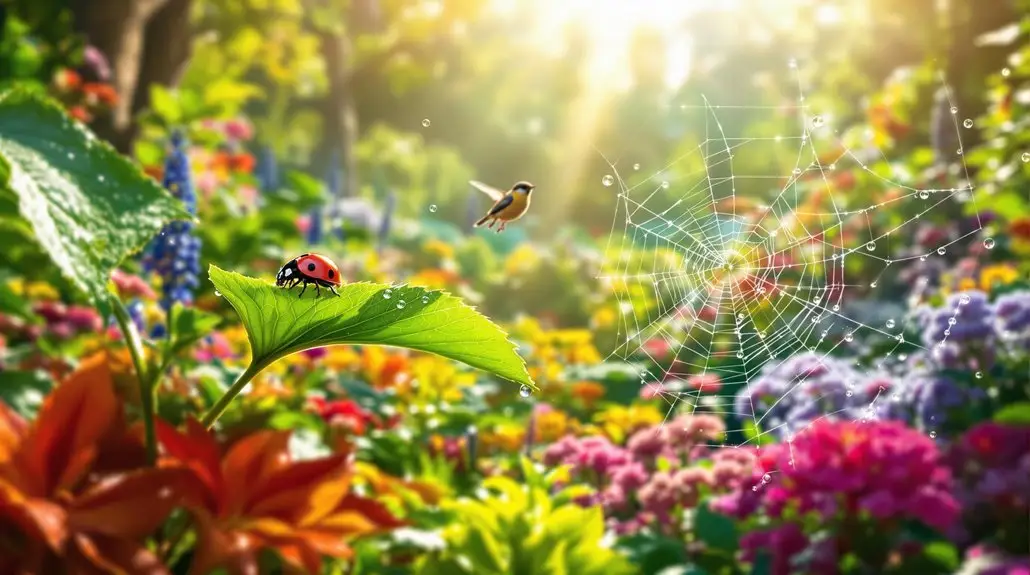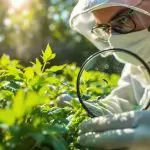Ecological pest management is essential for protecting your environment. By using sustainable practices, you can reduce reliance on harmful chemicals and enhance biodiversity. Start by selecting crops suited to your local conditions and employing crop rotation to disrupt pest life cycles. You can also improve soil health with organic practices and cover cropping. Utilizing biological control, like introducing beneficial insects, helps manage pests naturally. Plus, implementing preventive measures, such as maintaining cleanliness, keeps pests at bay. This holistic approach not only protects your crops but benefits the ecosystem overall. Discover more strategies to enhance your pest management practices.
Key Insights
- Ecological pest management reduces reliance on harmful pesticides, protecting both the environment and human health.
- Implementing crop rotation and intercropping enhances soil fertility and disrupts pest life cycles.
- Utilizing biological control methods promotes biodiversity by introducing natural predators for pest control.
- Maintaining cleanliness and using physical barriers can effectively prevent pest infestations in gardens and structures.
- Regular monitoring and timely intervention help manage pest populations while minimizing environmental impact.
Importance of Ecological Pest Management
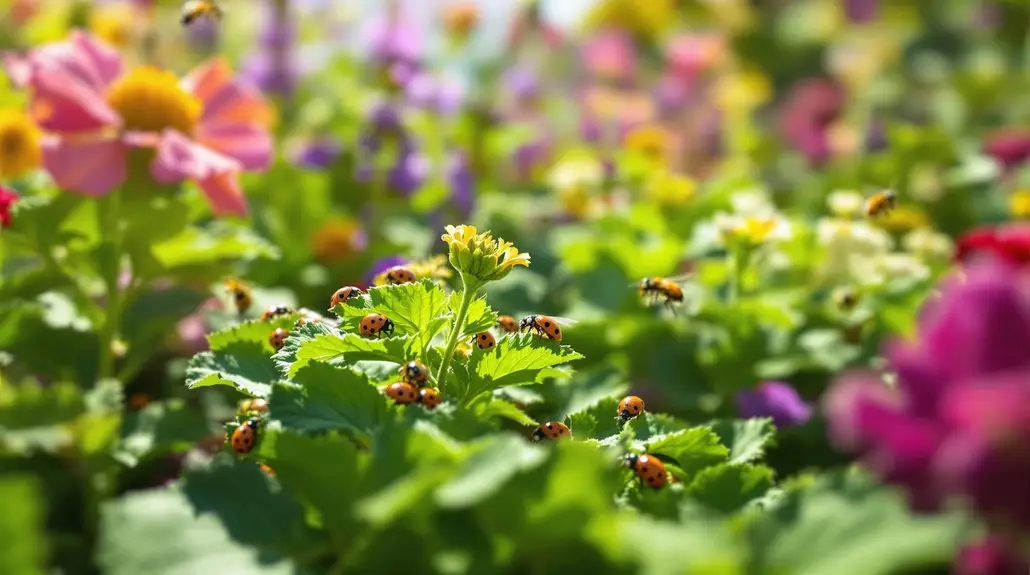
When it comes to farming, understanding the importance of ecological pest management can make a significant difference for both the environment and your health. By adopting these practices, you reduce reliance on broad-spectrum pesticides, which minimizes environmental harm. This approach not only benefits your crops but also creates a thriving habitat for beneficial insects and other natural predators, promoting biodiversity on your farm.
You’ll also find that ecological pest management helps maintain soil health and prevents issues like compaction and erosion. With reduced tillage and the use of cover crops, you’re building organic matter and fostering a healthier ecosystem long-term. This means you’re not just farming for today but also for future generations. Additionally, by focusing on crop management, you can enhance pest resistance and improve overall yield stability. Implementing organic pest control methods can further ensure the safety of your products and the environment.
From a health perspective, minimizing exposure to hazardous chemicals protects you, your family, and your farm workers from serious health risks. You’ll also shield pets and other non-target species, ensuring a more secure environment for all.
Economically, you can market your products as organic or sustainably produced, allowing you to command higher prices. Plus, by using integrated and biological control methods, you reduce the risk of pesticide resistance, cutting long-term costs associated with chemical applications.
Ultimately, embracing ecological pest management fosters resilience and adaptability in your farming practices, supporting local economies and creating a sense of belonging within your community. You’re not just a farmer; you’re a steward of the land, working towards a healthier, more sustainable future.
Crop Management Strategies
How can you effectively manage crops to enhance both yield and pest resistance? Start by selecting the right crops for your local climate and soil conditions. Opt for pest-resistant and well-adapted varieties that thrive in your area.
Including different varieties of the same crop can provide genetic resistance, creating a buffer against diseases and pests. Choose cultivars with built-in defenses to minimize susceptibility to insects and diseases, ensuring your plants grow healthy and strong.
Crop rotation and intercropping are powerful strategies too. Implement legume-based rotations to boost soil fertility and disrupt pest life cycles. Alternating unrelated crops can break cycles of disease, insects, and weeds, while intercropping enhances biodiversity and reduces pest pressures. Additionally, prioritizing biodiversity can stress pests and improve ecosystem resilience. In Florida, understanding the local pest dynamics, such as common pests like ants and roaches, is crucial for effective management.
Pay attention to crop spacing, as it can create conditions that are less favorable for pests.
Don’t overlook habitat management and biodiversity. By managing field boundaries and in-field habitats, you can attract beneficial insects that help control pest populations.
Create ecological islands within your fields to promote a diverse patchwork of crop and non-crop species. Utilize cover crops to protect your soil and nurture beneficial microbes, while also shading out troublesome weeds.
Soil Management Techniques
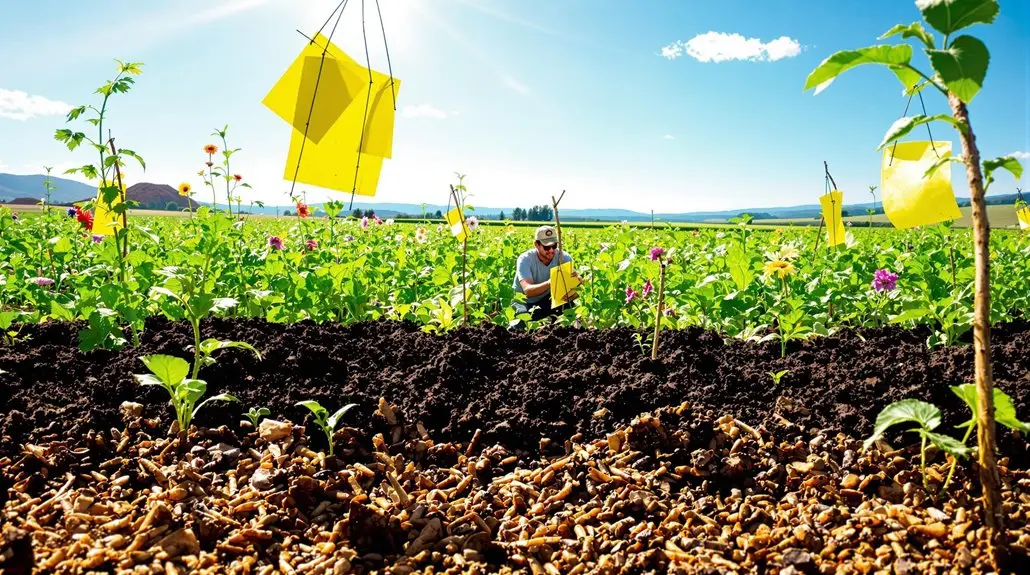
Effective pest management starts with strong crop management, but it doesn’t stop there. Soil management techniques play a significant role in creating a thriving ecosystem for your plants. By using organic manures and composts, you can maintain balanced pH and nutrient levels, ensuring your soil remains healthy. Adding earthworm castings and colloidal minerals supplements essential nutrients, while practices like cover cropping and conservation tillage can boost your soil’s organic matter from less than 1% to 3-8%.
Healthy soils lead to crops less damaged by pests, enhancing overall pest resistance. Implementing Integrated Pest Management (IPM) strategies can further support your pest management efforts by combining various control techniques while maintaining soil health.
Minimizing soil disturbance is important, too. Adopting no-till or reduced-till farming methods helps create a habitat for beneficial soil fauna. Keeping your soil covered with crop residue protects its health, while utilizing tools like the roller crimper in organic systems allows you to manage cover crops without herbicides. Avoiding intensive tillage preserves the communities of beneficial arthropods that support your crops.
Don’t forget to monitor and manage your soil quality. Periodic soil sampling will help you understand how your practices impact soil health over time. Evaluating the effects of pesticide use on soil microbial and fungal populations can guide your decisions.
Utilizing Biological Control
Biological control is a powerful tool in pest management that harnesses nature’s own predators to keep pest populations in check. By using methods like classical, augmentative, and conservation biological control, you can create a balanced ecosystem around your plants.
Classical biological control introduces beneficial insects to combat exotic pests, while augmentative approaches periodically release more natural enemies to boost their effectiveness. Conservation focuses on protecting the valuable predators already present in your fields. To enhance your efforts, consider collaborating with federal, state, tribal, and cooperative entities to maximize the impact of your biological control strategies.
One of the greatest benefits of biological control is its environmentally sound nature. You’ll reduce the reliance on broad-spectrum pesticides, which can harm non-target species. Plus, it’s often more cost-effective and sustainable. Once established, these natural enemies can maintain their populations without continuous external inputs. Additionally, utilizing eco-friendly solutions can further reinforce your pest management strategies.
Implementing biological control requires careful monitoring. You’ll need to observe both pest and natural enemy populations to verify that your strategies are effective.
Proper release and distribution methods help establish these beneficial agents, and post-release monitoring allows you to adjust your approach as needed.
Preventive Pest Management Practices
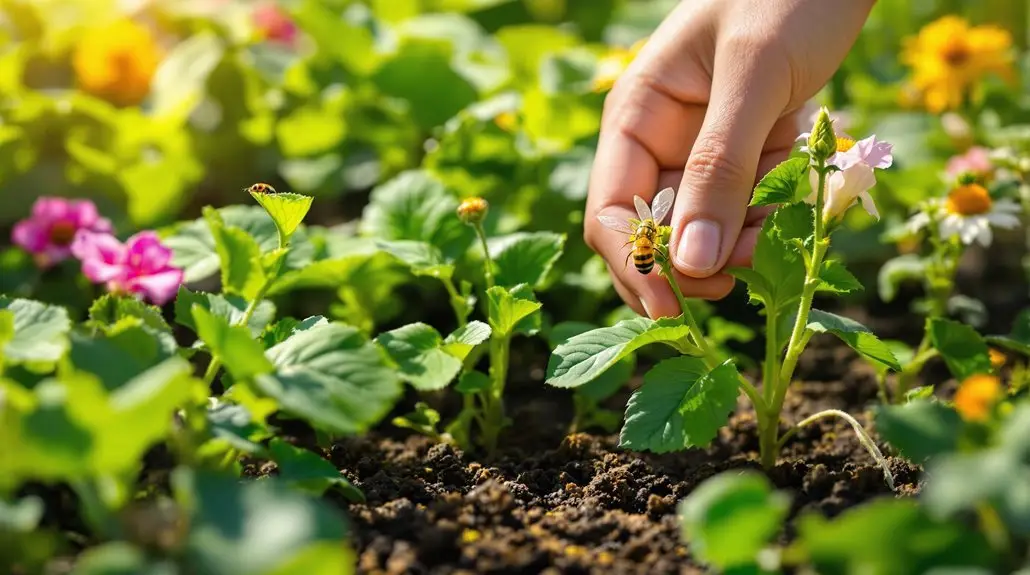
Preventing pest issues before they start is essential for maintaining a healthy environment in your home and garden. You can take several proactive steps to keep pests away and guarantee your living space remains comfortable.
Start by sealing gaps and cracks in walls, foundations, and around windows and doors using expanding foam or silicone-based caulk. This simple task can greatly reduce the chances of unwanted visitors.
Next, install fine mesh screens on windows and vents to block flying insects. Make sure your drainage systems are working correctly and repair any leaking faucets; excess moisture attracts pests. Implement physical barriers like door sweeps and steel wool around piping to deter rodents.
In addition to structural modifications, cleanliness is fundamental. Keep your living spaces tidy, store food in airtight containers, and dispose of trash regularly in sealed cans. Eliminating clutter, especially cardboard and newspapers, reduces potential hiding spots for pests. Maintaining strict cleanliness standards helps to reduce pest-attracting factors.
Don’t forget to clean up standing water, as it can lead to infestations. Regular inspections help you catch any pest issues early. Monitor for signs of activity, checking specific areas like under leaves and along foundations.
You might also consider adjusting your planting and harvest dates to avoid pest pressure in your garden.
Reactive Management Approaches
When pests exceed threshold levels, you need to act quickly to protect your crops. Balancing intervention strategies, like introducing beneficial insects or applying biopesticides, can help you tackle outbreaks effectively. Timely action is essential for minimizing damage and ensuring long-term pest management success. Implementing biological control methods can further enhance your approach by utilizing natural predators to keep pest populations in check. Additionally, employing environmentally friendly solutions can further safeguard your crops without harming beneficial organisms.
Importance of Timely Action
Timely action is essential in managing pest populations effectively, as delays can lead to significant crop damage and increased control costs.
By regularly scouting and monitoring, you can catch pest issues early, preventing them from escalating into full-blown outbreaks. Identifying pest species allows you to apply targeted control methods, ensuring you’re not wasting resources on ineffective strategies.
When you notice a pest outbreak, quick response is crucial. Implement reactive measures like releasing beneficial insects or using biopesticides that have minimal environmental impact. You can also prune plants and adjust your irrigation practices to reduce pest habitats, helping to curb their spread. For instance, the use of insect netting instead of row covers can improve pest exclusion for tender crops, enhancing your response efforts.
Incorporating integrated pest management (IPM) principles means using a combination of tactics—biological, cultural, and mechanical—to keep pest populations in check.
This approach minimizes reliance on broad-spectrum pesticides, promoting biodiversity and fostering natural pest control mechanisms.
Balancing Intervention Strategies
Often, balancing intervention strategies in pest management requires quick and informed decision-making. When preventive strategies fall short, it’s essential to act swiftly and effectively. Start by applying selected biopesticides that have a low environmental impact.
If pest populations exceed threshold levels, releasing beneficial insects can be a powerful method to restore balance. Remember, targeted spraying of pesticides should be your last resort, so weigh all other options first. Implementing an integrated pest management approach can enhance the effectiveness of your interventions.
Monitoring plays a key role in your reactive management approach. Set clear action thresholds and scout regularly to identify pest presence and assess damage. This helps you pinpoint problem areas and adjust your strategies accordingly.
When plant stress arises, consider using a chisel plow to alleviate soil compaction or adjusting irrigation to maintain proper moisture levels.
Combining reactive measures with preventive strategies fosters a holistic approach that benefits everyone involved. Be mindful of environmental sensitivity and guarantee that your reactive inputs align with your overall pest management system.
Frequently Asked Questions
How Does Ecological Pest Management Benefit Local Wildlife Habitats?
Ecological pest management benefits local wildlife habitats by fostering a diverse ecosystem that supports various species.
When you promote biodiversity, you create spaces for beneficial insects and wildlife, enhancing their food and shelter options.
By minimizing pesticide use, you protect pollinators and aquatic life, ensuring healthier habitats.
You’re also helping to maintain natural predator populations that keep pests in check, ultimately contributing to a thriving environment that everyone can appreciate and enjoy.
Can Ecological Pest Management Improve Crop Yields Over Time?
Absolutely, ecological pest management can improve crop yields over time.
By implementing strategies like crop rotations and conserving beneficial insect habitats, you’ll see healthier plants with fewer pests. This approach reduces the need for chemical pesticides, keeping your soil and ecosystem balanced.
As you create a more resilient farming system, you’ll likely enjoy increased yields and greater profitability, all while contributing to a sustainable environment where your crops—and community—can thrive.
What Are the Costs Associated With Implementing Ecological Pest Management?
When you consider implementing ecological pest management, you’ll face some initial costs like repairs, barriers, and staff training.
Long-term, labor costs might rise, but you’ll likely save on materials over time.
While some strategies can be pricier, you could also cut pesticide use and lower overall pest management expenses.
In the end, you’ll not only support sustainability but also align with a community that values responsible practices.
Are There Any Certifications for Farms Practicing Ecological Pest Management?
Yes, there are several certifications for farms practicing ecological pest management. You might consider Eco Certified, which showcases high-level practices, or Green Shield Certified, which emphasizes prevention-based pest control.
Additionally, the Rainforest Alliance Certification focuses on reducing pesticide use. If you’re in the Northeast, the Northeast Eco Apple Project sets mandatory ecological standards.
How Can Consumers Support Ecological Pest Management Practices?
You can support ecological pest management practices by choosing organic products and local farms that prioritize sustainable methods.
Engaging in community workshops and sharing your knowledge fosters a collective effort. You’ll find that collaborating with others on pest management plans creates a sense of belonging.
Additionally, advocating for eco-friendly pest control services and adopting practices in your home, like maintaining gardens and habitats, strengthens your commitment to a healthier environment for everyone.
Cultivate Harmony: Embrace Sustainable Farming with NaturePest Holistic Pest Control!
In your journey toward sustainable farming, embracing ecological pest management is like tending to a garden of balance and harmony. By implementing crop and soil management strategies, utilizing biological controls, and adopting both preventive and reactive practices, you can protect your environment while nurturing your crops. This holistic approach not only secures your harvest but also fosters a resilient ecosystem, ensuring that both nature and agriculture thrive side by side for generations to come.
Join the movement for a healthier planet—choose NaturePest Holistic Pest Control to support your sustainable farming practices. Together, we can cultivate a thriving environment where your crops flourish and nature thrives. Act now and make a positive impact on your farm and the world around you!

